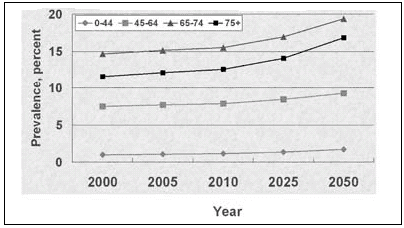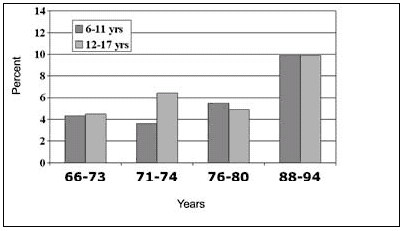Interim Report:
Proposed Recommendations for Action
Historical
This webpage is archived for historical purposes and is no longer being maintained or updated.
A National Public Health Initiative on Diabetes and Women's Health
Return to the Contents
Background
The Diabetes Burden Among Women
Diabetes mellitus is a disease caused by the body’s inability to produce or properly use insulin, a hormone required to convert sugar, starches, and other food into energy. There are three main types of diabetes. Type 1 diabetes is a disease in which the body does not produce any insulin. This form occurs most often in children and young adults and accounts for 5%–10% of all cases of diabetes. Persons with type 1 diabetes must take daily insulin injections to stay alive. Type 2 diabetes is a metabolic disorder resulting from the body’s inability to make enough, or properly use, insulin. Type 2 diabetes is the most common form of the disease, accounting for 90%–95% of diabetes. Primary interventions involve a healthy diet and physical activity. The third type, gestational diabetes, is a form of glucose intolerance that is diagnosed in some women during pregnancy. Treatment is required to normalize maternal blood glucose levels and avoid complications for the infant. After pregnancy, 5%–10% of women with gestational diabetes are diagnosed with type 2 diabetes, and 20%–50% develop type 2 diabetes in the next 5–10 years.
Diabetes can be associated with serious complications and even premature death. The burden of diabetes for women is unique because the disease can affect both mothers and their unborn children. With the increasing life span of women, the rapid growth of minority racial and ethnic populations in the United States (who are hardest hit by the diabetes burden), delayed initiation of childbearing, and the recent increase in new cases of diabetes among younger women in their teen years, the number of women at high risk for diabetes and its complications will continue to increase. These trends will place added demands on the health care delivery system and other sectors of society associated with determinants of health such as political, environmental, and civic entities. Although researchers have not yet identified the cause of diabetes, they have concluded that both genetic and environmental factors, such as obesity and lack of physical activity, play a major role. Lifestyle interventions designed to promote weight loss, increase physical activity, and improve diet can significantly reduce and delay the incidence of type 2 diabetes among persons at high risk for the disease.
Diabetes Is a Serious and Growing Public Health Problem
- By the year 2050, the number of persons with diagnosed diabetes is projected to rise from 11 million to 29 million.
- More than 17 million Americans have diabetes.
- One million new cases of diabetes are diagnosed each year.
- Diabetes costs the United States about $100 billion annually, including $44 billion for direct medical care and $54 billion for indirect costs associated with disability, work loss, and premature mortality.
- Persons diagnosed with diabetes are at twice the risk of death as those without diabetes.
- Diabetes is the sixth-leading cause of death and the primary cause of blindness, non-traumatic amputations of lower extremities, and kidney failure among adults.
Projected trends in prevalence of diagnosed diabetes among women by age, 2000 to 2050

Source: Diabetes Care, 2001
Note: A text version of this information
is available.
The Effects of Diabetes on Women Are Unique and Profound
- More than half (9.1 million) of the cases of diabetes occur among women.
- From 1990 to 2000, the prevalence of diabetes increased almost 50% among women.
- The prevalence of diabetes among women aged 45-55 years was less than 2% in the 1960s, but rose consistently in the 1980s and 1990s. In the early 1990s, the rate was about 6%.
- Women in minority racial and ethnic groups are the hardest hit by type 2 diabetes; the prevalence is about two to four times higher among black, Hispanic, American Indian, and Asian Pacific Islander women than among white women. Because minority populations are expected to grow at a faster rate than the U.S. population as a whole, the number of women in these groups who are diagnosed with diabetes will increase significantly over the coming years.
- Diabetes is a more powerful cause of heart disease among women than men.
- The prognosis of heart disease, the most common complication of diabetes, is more serious among women than men. Among persons with diabetes who have had a heart attack, women have lower survival rates and poorer quality of life than men do.
- Many older women with diabetes live alone and are poor. Poverty is also a major concern for women of childbearing age who have diabetes.
Percent of women with annual household income <$25,000.

Adjusted for age, race/ethnicity, marital status, size of household, and
employment status
Source: BRFSS, 2000.
Note: A text version of this information
is available.
Diabetes Affects Women at Various Life Stages Differently
The Adolescent Years (10-17 Years)
- About 61,500 females younger than 20 years old have type 1 diabetes; 92% are white, 4% are black, and 4% are Hispanic or Asian American.
- Type 2 diabetes is now being diagnosed more frequently among youth of all racial and ethnic groups and is more commonly diagnosed among girls than boys.
- The rate of death is nearly five times greater among girls with type 1 diabetes than among the general population of girls aged 10–17 years.
- By age 20 years, 40%–60% of persons with diabetes have retinopathy, or diabetic eye disease. Retinopathy can lead to blindness if untreated. The risk for developing proliferative retinopathy, the most severe form, is higher for girls than boys.
- Eating disorders may be higher among young women with type 1 diabetes than among young women in the general population.
Trends in Obesity Prevalence among Girls in the United States, 1966–1994

Source: Pediatrics, 1998
Note: A text version of this information
is available.
The Reproductive Years (18-44 Years)
- An estimated 1.85 million women of reproductive age have diabetes; about 500,000 of them do not know they have the disease.
- The death rate for women aged 25-44 years with diabetes is more than three times the rate for those without diabetes.
- Women of minority racial and ethnic groups are about two to four times more likely than non-Hispanic white women to have type 2 diabetes.
- Estimates of the overall prevalence of gestational diabetes in the United States range from 2.5% to 4% of pregnancies that result in live births. Most cases of this type of diabetes result from the body’s resistance to the action of insulin and may be precipitated by the increased insulin resistance that normally occurs during pregnancy.
- Gestational diabetes usually ends after the baby is born, but women with gestational diabetes have a 20%-50% chance of developing type 2 diabetes in the next 5-10 years.
- Poorly controlled diabetes during the first trimester can result in congenital malformations and spontaneous abortions, while in the second and third trimesters of pregnancy it can result in excessively large babies, posing a risk to both the mother and child during delivery.
- Children exposed to diabetes in utero have a greater likelihood of becoming obese during childhood and adolescence and of developing type 2 diabetes later in life.
The Middle Years (45-64 Years)
- Approximately 1.73 million women aged 45-64 years have diabetes.
- For middle-aged women, type 2 diabetes is at least twice as common among racial and ethnic minority groups as among whites.
- Diabetes is a leading cause of death among middle-aged American women.
- Coronary heart disease is an important cause of illness among middle-aged women with diabetes; rates are three to seven times higher among women 45-64 years old with diabetes than those without diabetes.
- In 2000, at least one in four women aged 45-64 years with diabetes had a low level of formal education, and one in three lived in a low-income household. Women with diabetes were more likely to have a low socioeconomic status regardless of race, ethnicity, or living arrangements (marital status, size of household, and employment status).
Percent of women with less than high school education by age, diabetes status

Adjusted for age, race/ethnicity, marital status, size of household, and
employment status.
Source: BRFSS, 2000.
Note: A text version of this information
is available.
The Older Years (65 Years and Older)
- About 4.5 million women aged 60 years and older have diabetes; one quarter of them do not know they have the disease. Most elderly women with diabetes have type 2 diabetes.
- On average, women live longer than men. Because elderly women live longer than men, there are nearly twice as many older women than men. Elderly women with diabetes also outnumber elderly men with diabetes. Diabetes is one of the leading underlying causes of death among women aged 65 years and older.
- Being older and having diabetes accelerate diabetic complications such as heart disease, stroke, kidney disease, and blindness. Elderly women with diabetes are at particularly high risk for heart disease, visual problems, hyperglycemia or hypoglycemia, and depression.
|
Factors That Place Women at Risk for Diabetes and Its Complications Women face increasing risk of diabetes and its complications because of certain social and economic trends. Increasing numbers of women:
|
Initiative on Diabetes and Women's Health
As part of a comprehensive effort to improve women’s health, the Centers for Disease Control and Prevention (CDC) established the National Public Health Initiative on Diabetes and Women’s Health. The initiative has three phases. In Phase I, Diabetes & Women’s Health Across the Life Stages: A Public Health Perspective was prepared. This report, published in 2001, examines the issues that make diabetes a serious public health problem for women; analyzes the epidemiologic, psychosocial, socioeconomic, and environmental dimensions of women and diabetes; and discusses the public health implications. This landmark document explores the impact of diabetes on women’s lives by using a framework that defines the issues across various life stages: the adolescent, reproductive, middle, and elderly years.
Following Phase I, CDC joined forces with the American Diabetes Association (ADA), the American Public Health Association (APHA), and the Association of State and Territorial Health Officials (ASTHO) to convert the information contained in the 2001 report into a plan of action (Phase II). Toward this end, the four cosponsoring agencies formed a task force of selected individuals representing over 40 organizations from the public, private, and voluntary sectors. The task force convened on November 1-2, 2001, in Washington, D.C., to begin to identify needed strategies, policies, surveillance, and research for improving the lives of women diagnosed with or at risk for diabetes. Recommendations that emerged from this meeting were compiled into a draft document, which was circulated to task force members and other experts for review. The result was this Interim Report: Proposed Recommendations for Action.
Phase III of the initiative will involve preparing and implementing the National Public Health Action Plan on Diabetes and Women’s Health. The proposed recommendations contained in the interim report will be expanded during a working summit in August, 2002. At this meeting, invited officials from multidisciplinary agencies (including government, academic, voluntary, business, community-based, and professional organizations) will become more familiar with the proposed recommendations from Phase II, select those of highest priority, identify appropriate strategies for implementation, recommend lead agencies for implementation, and propose time frames for action and results. Attendees will include representatives of many of the organizations on the task force, along with others likely to have a major role in implementation.
Contact Us:
- CDC Diabetes Public Inquiries
- 800-CDC-INFO
(800-232-4636)
TTY: (888) 232-6348
8am-8pm ET
Monday-Friday
Closed Holidays - cdcinfo@cdc.gov


